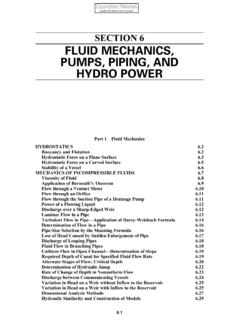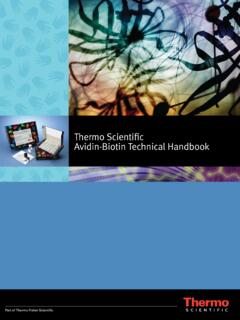Transcription of PHOTOMULTIPLIER TUBES principles & applications
1 PHOTOMULTIPLIER TUBES . principles & applications Re-edited September 2002 by S-O Flyckt* and Carole Marmonier**, Photonis, Brive, France *. Email: **Email: i FOREWORD. For more than sixty years, photomultipliers have been used to detect low-energy photons in the UV to visible range, high-energy photons (X-rays and gamma rays). and ionizing particles using scintillators. Today, the PHOTOMULTIPLIER tube remains unequalled in light detection in all but a few specialized areas. The PHOTOMULTIPLIER 's continuing superiority stems from three main features: large sensing area ultra-fast response and excellent timing performance high gain and low noise The last two give the PHOTOMULTIPLIER an exceptionally high gain x bandwidth product. For detecting light from UV to visible wavelengths, the PHOTOMULTIPLIER has so far successfully met the challenges of solid-state light detectors such as the silicon photodiode and the silicon avalanche photodiode.
2 For detecting high-energy photons or ionizing particles, the PHOTOMULTIPLIER remains widely preferred. And in large-area detectors, the availability of scintillating fibres is again favouring the use of the PHOTOMULTIPLIER as an alternative to the slower multi-wire proportional counter. To meet today's increasingly stringent demands in nuclear imaging, existing PHOTOMULTIPLIER designs are constantly being refined. Moreover, for the analytical instruments and physics markets, completely new technologies have been developed such as the foil dynode (plus its derivative the metal dynode) that is the key to the low-crosstalk of modern multi-channel photomultipliers. And for large detectors for physics research, the mesh dynode has been developed for operation in multi-tesla axial fields. Recent developments include very large hemispherical photomultipliers with excellent time response for cosmic ray experiments, and ultra-fast TUBES with a time jitter of less half a nanosecond.
3 This book describes the operating principles of the PHOTOMULTIPLIER tube and surveys its many diverse applications , such as medical imaging, nuclear and high-energy physics including the latest cosmic-ray research aimed at opening new windows on the universe. ii CONTENTS. CHAPTER 1 Operating principles and construction CHAPTER 2 Fundamental characteristics CHAPTER 3 Dark current and noise CHAPTER 4 Operating characteristics and considerations CHAPTER 5 Supply and operating advices CHAPTER 6 Scintillation counting CHAPTER 7 applications of scintillation counting and analysis CHAPTER 8 Non-scintillator applications of photomultipliers iii INDEX. absolute spectral sensitivity 2-2 Animal PET 7-11. absorbed photon flux 1-25 ANTARES 8-17. absorption coefficient 1-27 applying voltage 5-2. activation analysis 7-17 attenuation length 6-6.
4 Active dividers 5-10 AUGER 8-19. aerogel 8-14 Auger electrons 1-33. afterpulses 4-40 autocorrelation function 3-11, 5-46. afterpulse ratio 4-40 azimuthal response 7-5. luminous reactions 4-40, 4-53. residual gases 4-40 back scattering 1-34, 2-9. AGASA 8-19 back scatter peak 6-25. air-shower experiments 8-18 background radiation 3-5. aluminium layer 1-8, 1-9 BaF2 cameras 7-8. AMANDA 8-17 bandgap 1-27, 1-30. Altuglas 6-5 bandwidth effects 3-25, 3-27. ambient light 3-6 bar code scanners 8-8. ambient pressure 4-54 BBQ 6-6. ambient temperature effects 4-42 Benthos sphere 1-23. analytical applications 9-11 beta sources 7-9. liquid scintillation counting 7-12 BGO 7-10. radio-immuno assay (RIA) 7-15 binomial distribution 3-10. angle of incidence 4-9 bioluminescence 8-2. Animal PET 7-11 bipolar layer 1-30.
5 Annihilation peak 6-25 blue sensitivity 2-3. anode body scanners 7-6. a current generator 1-17 Boltzmann constant 3-3. blue sensitivity 2-7 BooNE 8-15. collection space 1-16, 4-25 BOREXINO 1-15. collection grid 1-16, 4-25 borosilicate 1-7, 4-54. load 5-21, 6-9 box dynodes 1-14. luminous sensitivity 2-7. mosaic 1-21 calorimeters radiant sensitivity 2-7 electromagnetic 7-25. resistor 5-17 fibre 7-27. response pulse width 2-9, 4-58, 6-9 hadronic 7-26. rise time 2-10, 4-6, 4-58 lead glass 7-27. spectral sensitivity 2-2 VPD and VPT 7-27. typical anode pulse 2-9, 4-58 cardiac cameras 7-6. anode load 5-21, 6-9 cathode current continuous operation 5-21 cut-off voltage 1-11. pulse operation 5-22, 6-8 fluctuations 3-11. anode pulse rise time 2-10, 4-6, 4-58 proportionality 1-11. delta pulse response 2-9, 4-56, 4-58 saturation 1-11.
6 Step response 2-10, 4-56, 4-58 cathode resistivity 2-16, 4-26. anode response pulse width 2-9, 4-10 cathode sensitivity 2-2. I-1. CdWO4 6-35 reduction 5-33. CdZnTe 7-8 stabilization time 2-17, 5-3. centre-edge difference 2-11, 4-14 thermionic emission 3-3, 4-48, 5-33. chance coincidence rate 7-14 dark pulses 2-12, 4-52, 5-3. channel PMT 1-23 decoupling capacitors 5-11. chemiluminescence 8-2 dead time 6-16. Cherenkov effect 8-12 delta function 2-9, 2-12, 4-56, 4-58, 4-61. aerogels 8-14 centre-edge difference 2-11, 4-14. detectors 8-12, 8-16, 8-18 jitter 2-11, 4-15. formula 8-12 response 2-9, 4-19, 4-56, 4-58. gases 8-14 standard deviation 2-11. in PMT window 3-5, 4-53 time resolution 2-11, 4-60. Child-Langmuir equations 4-25 transit-time difference 2-11. circular cage dynodes 1-15 transit-time spread 2-11, 4-15, 4-17.
7 CLIA 7-16, 8-2 density measurement 7-20. collider detectors 7-23 depth-of-interaction 7-8. cold emission 3-4 detectivity 3-24. collection efficiency 1-8, 1-12, 2-5, 4-7, 4-8 distance curve 7-4. relative 2-5 drift compensation 5-38. collimators 7-2, 7-7 DUMAND-Hawaii 8-16. Compton DUMAND-Lake Baikal 8-16, 8-18. backscattering 2-9, 7-22 dynode edge 6-24 box dynodes 1-14. effect 6-24 circular cage 1-15. conduction band 1-26, 6-29 crossed-field 1-18. conductive coating 5-3 emission coefficient 1-13. construction 1-2 foil 1-16. continuous mode 6-14 GaP(Cs) 1-17. cooling 4-49, 5-33 geometry 1-14, 1-15. cosmic ankle 8-19 iterative 1-12. Corning blue sensitivity 2-2 linear focusing 1-9, 1-14. cosmic background 3-5, 4-53 material 1-13. cosmic-ray detectors 7-30, 8-14 mesh 1-15. counting accuracy 6-16 microchannel plates 1-18.
8 Counting plateau 6-15 signal 5-19. CPM 1-23 venetian blind 1-9, 1-14. cross talk 1-21. CsF 7-10 electrolysis of glass 3-8. current amplification 1-3 electron diffusion 1-28. CZT 7-8 electron multiplier 1-12. electron-optical input 1-8, 7-5. dark current 2-12, 3-2, 4-52, 5-3, 5-33 triode 1-9. exposure to light 3-6 emission spectrum 6-38. field emission 3-4 energy bands 1-26. leakage current 2-17, 3-2, 4-49, 4-54 energy resolution 2-14, 3-14, 3-19, 6-20. measurements 2-17 energy dependence 2-14. piezoelectric effects 2-18 radiation sources 2-15, 6-21, 6-25, 7-9, 7-12, pulse rate 2-18, 4-52, 5-3 7-14, 7-18, 7-24, 7-25. pulse spectra 2-14 statistical fluctuations 2-14. I-2. with scintillators 2-15, 3-14, 3-19 energy window 7-3. energy spectrum 6-21 fall off curves 7-4. composition 6-24 PHR 7-6.
9 Energy spectrometry 6-19 spatial resolution 7-6. environmental considerations 4-42 SPECT 7-7. atmosphere 4-54 stability 7-4. magnetic fields 4-51 summation signals 7-3. mechanical stress 4-55 tomography 7-7. radiation 4-52 uniformity 7-4. temperature 4-42 weighting factors 7-3. expectation value 6-17 whole body 7-6. exposure gamma sources 7-22. ambient light 3-6 GaP(Cs) dynodes 1-17, 1-19. humidity 4-54, 5-3 gating 5-37. light flash 3-6 Gaussian distribution 3-14. radiation 4-52 Gaussian light pulse 4-60. temperature 4-43 general purpose TUBES 1-8. equipotential lines 1-8 GRB 8-18. equivalent anode dark current input 3-23 green sensitivity 2-5. equivalent noise bandwidth 3-24, 3-32 GSO 6-35, 7-11. equivalent noise input 3-23 GZK theory 8-19. escape depth 1-28. escape peak 6-25 He penetration 4-39, 4-40, 4-54.
10 HEGRA 8-18. fall-off curve 7-4 hexagonal array 7-6. FDG 7-10 high energy physics 7-23. feedback resistance 4-2 high pressure 4-54. Fermi level 1-26 high-voltage polarity 3-8, 5-2. field emission 3-4 HiRes 8-19. filtered sensitivity 2-2 hodoscopes 7-30. flame spectrometry 8-4 hot electrons 1-28. Fluor-18 7-10 HPD 1-23. flying spot scanners 8-8 humidity 4-54, 5-3. Fly's Eye 8-19 hybride PMTs foil dynodes 1-16. Fourier transform 3-12 ICECUBE 8-17. fused silica, quartz 1-7, 4-54 industrial gamma sources 7-22. FWHM 6-28 initial velocities 1-8, 4-16. inorganic scintillators 6-35. GaAs, GaInAs, GaInAsP 1-5, 1-27, 1-33 input optics 7-5. gain 1-2, 1-12, 4-6, 5-30 insulators 1-26. adjustment 5-30 integral quantum efficiency 6-33. curves 5-24 interference filters 2-16. fluctuations 1-12. gain-voltage characteristics 2-13 jitter 2-11, 4-15, 4-17.






